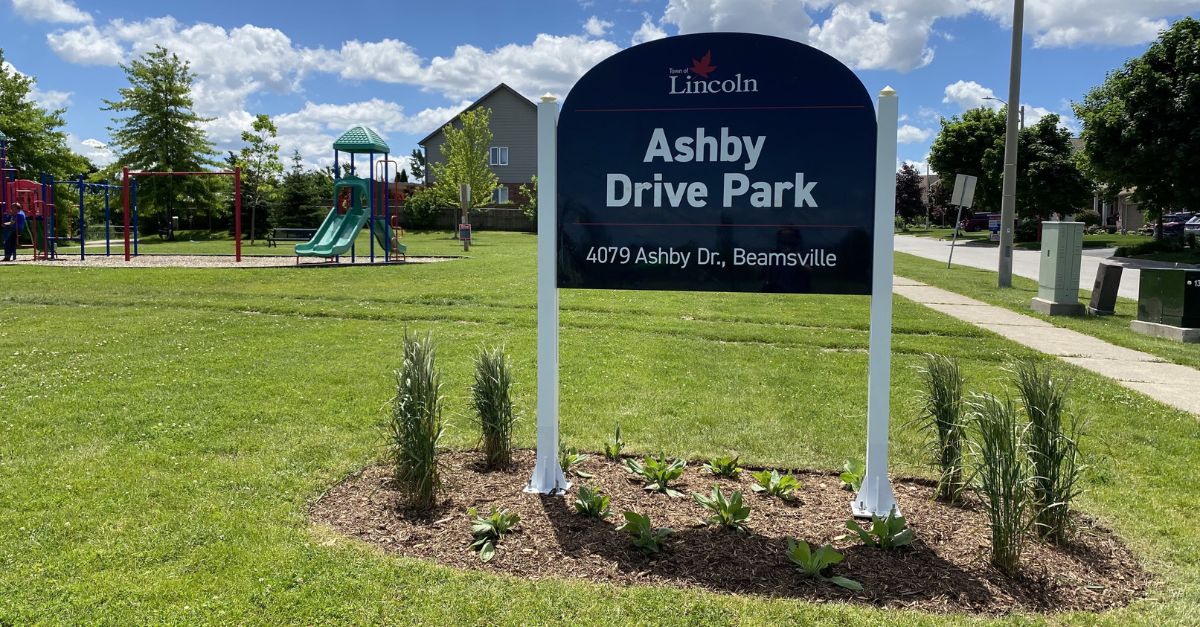
By Lilian Schaer
A combination of community engagement and a willingness to take a chance on an innovative approach has led to a creative and environmentally friendly stormwater management solution in one Ontario municipality. It not only reduces stormwater flows but also saves money and increases the chance that trees planted on site will grow and thrive.
Thanks to a partnership with a local horticultural innovation centre, the new absorbent landscape at Ashby Drive Park, a two-and-a-half-acre area of parkland in Beamsville, Ontario (part of the Town of Lincoln located in the Niagara Region) has become a real success story for other municipalities to emulate.
“This was an existing park with a lot of open space that could still be developed. Before the pandemic, we conducted an exercise in community engagement to understand what local residents wanted to see in the space,” explains Shannon McKay, Director of Community Services with Town of Lincoln. “Three quarters of the park was open green space and we heard from residents that they wanted more trees, shade and additional amenities.”
The Ashby Drive Park enhancement project included resurfacing and upgrading the existing basketball court, installing shade sail seating areas and fitness equipment, expanding the play area, converting to a rubber play surface and adding a ‘learn to ride’ bicycle playground complete with bicycle repair station.
However, how to best approach stormwater management while considering all the enhancements to the park was a challenge for the town. It had to develop a plan for handling stormwater, particularly following heavy precipitation events, where large amounts of water fall quickly in a short amount of time. As well, the water needed to be captured and stored for later use during dry periods.
A solution evolved from a discussion about low impact development with research scientists at the nearby Vineland Research and Innovation Centre (Vineland): creating an absorbent landscape that would not only fit the vision for the park but could also serve as a living demonstration site of science and research in action.
“With the guidance and support of the team at Vineland, we pursued the absorbent landscape project,” McKay notes. “It was a fantastic collaboration that let us avoid the traditional stormwater management processes and do something pretty unique and innovative.”
According to Rhoda deJonge, Director of Plant Responses and the Environment at Vineland, municipalities are increasingly turning to horticulture for green infrastructure solutions to some of their biggest problems, such as using large greenspaces to capture and use stormwater instead of letting it run off downstream.
According to deJonge, conventional stormwater management often treats precipitation as a waste product, but combining Vineland’s soil restoration research with stormwater management has provided a unique opportunity to irrigate vegetation, while capturing, storing and providing water for extended periods of time.
“During the urbanization process, we strip and stockpile topsoil for extended periods of time. During this process, we degrade and ultimately kill the topsoil but stockpile topsoil has the potential to be restored and reused,” adds Jason Henry, Laboratory Supervisor for Soils & Substrates and a member of deJonge’s team.
Working with the Town of Lincoln and a landscape contractor, the Vineland team tested the topsoil layer before removing and stockpiling it during the construction process of the park enhancement projects. Before reapplying the topsoil after construction was completed, they mixed in locally sourced compost and broke up the compacted subsoil left by the heavy construction equipment. Turf was then installed to finalize the new absorbent landscape soil.
It’s expected that by storing more water on site, this increased moisture – along with soil that is not pressed and compacted – will lead to additional benefits related to improved tree survivorship and growth on the site.
“The main thing we found is that while we can’t use all the water, we can use most of it, and so far, the amended soil is already taking in about 96 per cent of the precipitation that hits this section of the park,” says deJonge. “Once the soil matures and trees start growing as well, we’ll see this number continue to increase.”
Vineland’s urban greening research is proving that it’s tough to judge the health of soils without proper analysis. Often, a quick look at soil nutrients will not illustrate how well a soil can function and whether it can grow the trees or turf needed for urban landscapes.
The team’s soils laboratory looks at numerous key parameters that determine whether a soil is healthy or not and provides clear advice and recommendations to municipalities on how to start the path to ‘fix’ their soils.
That’s why Vineland developed the Town of Lincoln’s first soil specification, which includes advice on how the soils could act like a sponge as they mature, keeping water from running off overland and into local creeks where it has the potential to contaminate the water or harm wildlife. It will also ensure whatever plantings are implemented have the best chance at survival.
As part of Vineland’s Greening the Landscape Research Consortium, the Town of Lincoln is also working on a case study project to better understand the role healthy soils can play in how well trees and turf survive and thrive in urban parks.

-30-
Follow Bioenterprise on social media or subscribe to our channels for the latest industry news, events, and business development opportunities.